It’s not all that often that visual effects artists get to work on super stylistic TVCs featuring bunny rabbits and giant headlights. The Mill’s head of 3D Tom Bussell walks us through his work on ‘Oomph’, a fast-paced monochrome spot for the Audi A1 directed by Rogue Film’s Sam Brown for agency BBH.
fxg: How would you categorize this spot – it seems different than most car TVCs?
Bussell: It definitely had the feel of an art project, but it showcases the main features of the new small Audi – the sat nav, the air con unit, the sound system and the headlight technology. The shots are treated as beauty shots, kind of like product shots without being product shots. The director Sam Brown’s vision for the studio shoot was spot on. So they’re watching the sat nav in a cinema, we’ve got a girl floating weightlessly with a parachute with the fan for the air con, and we’ve got the rabbits in headlights and a guy strumming a guitar that’s rigged up to the speaker like a giant amp.
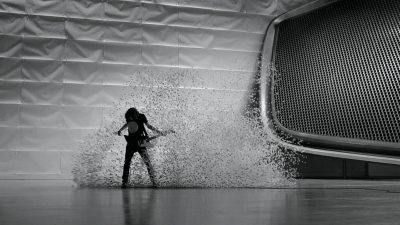 fxg: How early did The Mill get involved with the commercial and what kind of design work did you do?
fxg: How early did The Mill get involved with the commercial and what kind of design work did you do?
Bussell: Well, we knew early on what the products were because they exist in the car – we just had to do giant versions of them. We spoke to Sam prior to the shoot and we were involved in the pre-production side of it. Sam was keen to have structures actually there on set for blocking. That gave us real light interaction, real shadows, real highlights and a sense of scale. Later on, we would build CGI versions of those and replace what was there, but we still kept the fundamental lighting and shadows. For example, the Bose speaker resting up against the wall has a shadow that we just kept there. They built a big frame the same shape as the actual speaker itself. It also helped the DP light it on set and frame the shots.
Prior to the shoot we actually made a previs to show how big these elements should be compared to their original. We did specific scales for each one, say the headlight, and positioned them in a space on the set. That meant the production company knew exactly how big to build the objects and the set.
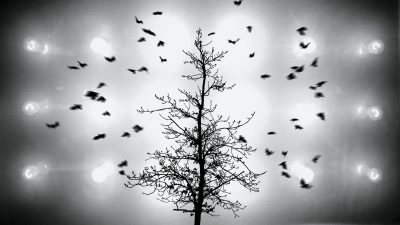 fxg: How did they go about shooting the live action for the spot?
fxg: How did they go about shooting the live action for the spot?
Bussell: It was shot over two days in basically one big hall, and they had these big objects on wheels, so that once they’d finished shooting one they’d be able to change the set around quickly and wheel in the other one. There were two units, the first one shooting the hero elements like the giant car parts. The second unit worked on all the different elements – abstract cut-aways, a tree, logos and some other content to explain what the commercial is all about.
fxg: What kind of survey data did you need to take on set?
Bussell: We did do the normal survey measurements, but I was also focussing on making sure we had the right lighting from the set. We took our Spheron camera – it’s a camera device that takes a full 360 HDR photo of the set, with 22 exposures. It goes from completely over-exposed to the filament of the bulb. So it gives you all the range we need to be able re-light the CG objects. It was perfect for this job because it gave us perfect reflections to reflect back into our CGI and add all our imperfections. I’d say the Spheron took us about 60 per cent of the way and then there was a lot of manual art direction on top.
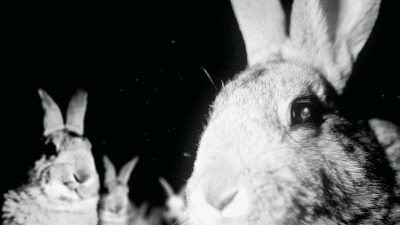 fxg: For the oversized objects, what were some of the challenges in scaling those up?
fxg: For the oversized objects, what were some of the challenges in scaling those up?
Bussell: They’re not the kind of objects that scale very easily, because they don’t have much detail in them. To make them fit into the scene we had to add a lot of imperfections into the objects, so that they wouldn’t just feel like objects that had been scaled up – they had to feel like they were engineered to be that big. Obviously a speaker made to fit in your car is made out of one mould or a few pieces, but if you were to build it 100 times bigger, how would you build it? If it was a piece of glass or metal, there would be all these imperfections and scratches in it.
The speaker also had a lot of tiny highlights and scratches which we added, even though the result is that it still looks extremely pristine. But without those imperfections I think you would just feel like that had been scaled up without any detail added. We had three weeks of production time so we were able to build all the objects up front, by looking at the originals, and we also got CAD data from Audi with all the technical specifications.
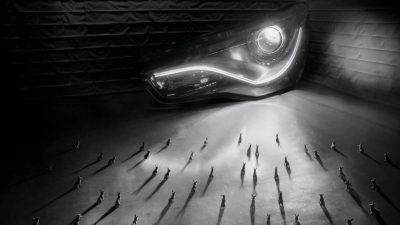 fxg: There’s a wide shot of the headlamp with the rabbits in there. Can you talk about that?
fxg: There’s a wide shot of the headlamp with the rabbits in there. Can you talk about that?
Bussell: We actually had a ton of live action rabbits on set, and we were trying to get them to react to something, but that was fairly tricky. Being domestic rabbits, they weren’t phased by anything. So we ended up building a CGI version of the rabbit with fur and everything in XSI and ZBrush order to get the wide shot, where we see the giant headlamp.
It helped that we knew the exact shot that would be required for the rabbits. We tailored everything to be shown from that angle, for example, we didn’t really need to build CG eyes for that shot. It made sense to be as efficient as possible, especially with only three weeks of production time. On the actual headlight, there are so many reflections and refractions in it, so we took one of the real headlights out of the car and placed it on the ground. We shot some references of that with different exposures and combinations of light so that we could see what lighting effects it had, so we didn’t have to make it up.
On the actual set itself, they had the large prop and shot different lighting passes with set lights. We mixed some of the reference that we shot in as well. There were a fair few layers to comp in Nuke – 20 or 30 layers – just to get the effects we needed and to clean up the floor as well.
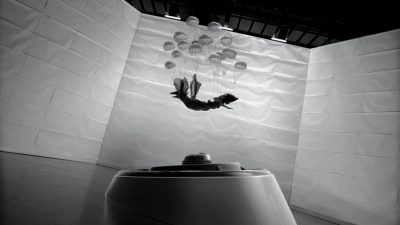 fxg: It’s obviously a black and white spot – how did that affect your CG work and the final look?
fxg: It’s obviously a black and white spot – how did that affect your CG work and the final look?
Bussell: In theory, a black and white spot should be simpler, because you don’t have to worry about color temperature. You’ve got 256 types of black and grey as opposed to millions of colors. But it still has its own challenges. To make sure we were matching correctly, we built and rendered all of our CG in color and matched this to the color plate. For some of the objects, they had specific bright colors like red and other primaries. So we thought it was better to match what it really should look like before we converted to black and white. After we rendered our CG we took all our saturation out and graded it to fit the graded telecine plate.

i love this spot. very artistic… very modern. bravo. thx for the interview FXinsider!